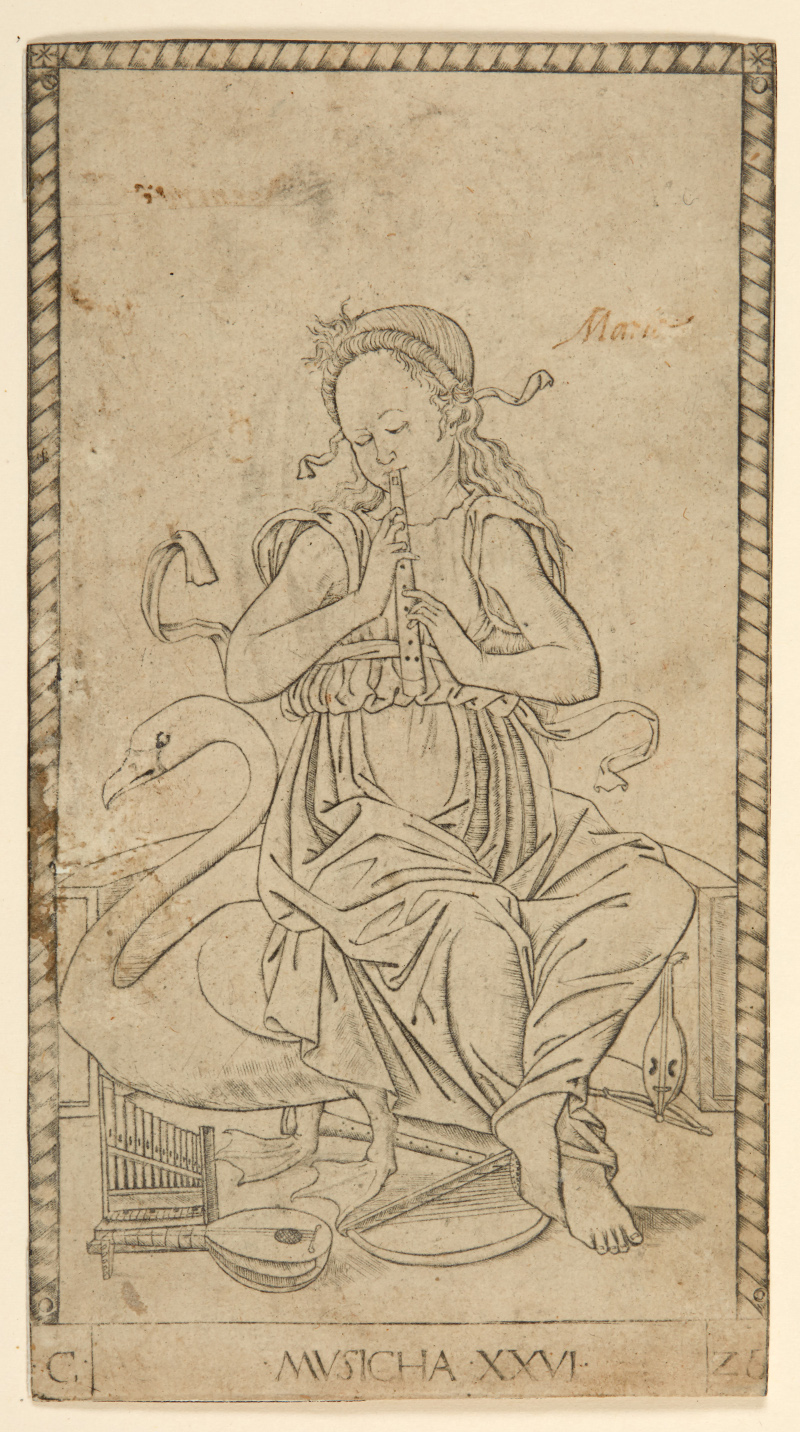Engraving in silver-grey.
Size of sheet: 18 x 9.9 cm.
Inscribed in brown ink: Maris (?).
Mounted on an album sheet (18th century).
Literature: Hind 1938-48 E.I.26; Mark J. Zucker (2000) in: T.I.B. 24.2406.026a. (B. 43-A) (E-Series, no. 26).
Provenance: Grafische Sammlung der Albertina, Vienna, (Duplicate and deaccession stamp), (Lugt 5e/h).
Although the impression looks weak at a first glance, it is printed in silvery grey ink and all details are faint but precisely printed.Our impression shows the full image and the borderline is visible all around, with some rubbing on the sheet. It has all the characteristics of a very early pull from the so called E-Series (see comment below), that is the earliest of the printing runs, here showing still some oil stains from printing at the very left side. In fact, as Landau and Parshall have noted, impressions of the E-Series are rare and “… characterized by their softness of tone and what appears to be a deliberate lack of interest in strong chiaroscuro: the formal goal of the engraver (or engravers) of this school seems to have been the creation of a subtle variety of greys rather than blacks. This effect was achieved by employing very thin and extremely regular, disciplined cross-hatching, coupled with the use of greyish inks, and was unwittingly intensified by the obviously deficient printing techniques employed in his workshop…” (Landau/Parshall p. 71f.). For the most comprehensive summary of inking of early plates see also Ad Stijnman.
The first version (called ‘E-series’) is of a group of fifty engravings traditionally known as the “Tarocchi Cards of Mantegna”. It is one of ten images in the third group of the set marked with the letter “C” and illustrates the ‘Liberal Arts’, branches of medieval and early Renaissance learning. Their iconography and order derive from the Marriage of Mercury and Philology (‘De Nuptiis Mercurii et Philologiae’), a fifth-century allegorical treatise by the North African author Martianus Capella who was active in the mid-fifth century. He described only the classical seven Liberal Arts and divided them into a lower group called Trivium (Grammar, Rhetoric and Dialectic) and a higher one called Quadrivium (Music, Geometry, Arithmetic and Astronomy). In the Tarocchi engravings the total number was raised to ten, with the addition to the Quadrivium of Poetry, Philosophy and Theology. In our print, the image does not derive from Capella’s text. Music is sitting on a swan and playing a flute, and there are several musical instruments on the ground. The composition is encircled by a frame of diamonds. The swan was known in antiquity for its love of music and was said to produce its most melodious songs before dying. (British Museum online).
The most complex survey on this set so far is by Mark J. Zucker, published in 2000 for the third volume of The Illustrated Bartsch Commentary andbegins as follows: … the so-called Tarocchi or Tarot Cards of Mantegna are without doubt among the most fascinating and problematical of surviving fifteenth-century prints. Although studied extensively and long regarded as highly significant examples of early Italian engravings, they have yet to disclose all of their secrets. Any discussion of them must begin by noting that the conventional title of the series, still in general use for want a better one, is in fact misleading, for the so called Tarocchi of Mantegna are not tarot cards at all, nor do they have any discernible relationship to Mantegna. (…) In reality, however, the style (…) points to Ferrara rather than Baldini’s Florence or Mantegna’s Padua or Mantua; and while they do have certain things in common with the true tarocchi, the latter are also very different in nature … . (Mark J. Zucker (2000) in TIB 24. 2406. (E-Series) p. 1 ff).
Our impression and all others are only known in a single state and no later impressions are known. All impressions show uniformly small circular marks at the four corners of the decorative borders, signs of holes resulting from the plates having been nailed down or riveted to, and then removed from a (wooden?) support prior to the process of printing. Such marks do not appear in the later S-series, but they are exceedingly common in niello prints and not uncommon in early Italian engravings generally; their significance remains somewhat conjectural. (Zucker p. 1 ff)
The British Museum in London has undoubtedly the finest known impression of a complete set 3 and our print can be considered from one of the group of the most desirable prints in early Italian printmaking.
(1) This might be the reason why the Albertina dismissed such a rarity in the late 19th century, when that impression was deaccessioned.
(2) Ad Stijnman,Engraving and Etching 1400–2000, A History of the Development of Manual Intaglio Printmaking Process, London and Houten 2012, p. 35 ff.
(3) Other impressions of the print are in Vienna; Paris; Boston; Florence (Galleria degli Uffizi and Biblioteca Nazionale); Chantilly; Cleveland; Hamburg; Paris (Rothschild collection, Louvre); Oxford; Naples; Rome; Washington; and elsewhere. The British Museum has a duplicate of the print, touched with brown wash and traces of gold (P&D 1842-8-6-17). A copy is known by Hans Ladenspelder (1511–1561), Hind 1938-48 I.237.26a (Copy).
Music

School of Ferrara known as ‘Tarocchi Cards of Mantegna’
1465